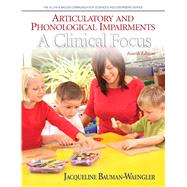
Note: Supplemental materials are not guaranteed with Rental or Used book purchases.
Purchase Benefits
What is included with this book?
Jacqueline Bauman-Waengler, Ph.D., is a Consultant, Speech/Language Specialist currently affiliated with Western Psychological Corporation in Los Angeles, California.
Contents
Preface
Chapter 1 Clinical Framework: Basic Terms and Concepts
Communication, Speech, and Language
Subdivisions of Language
Articulation and Speech Sounds: Phonology and Phonemes
Articulation Disorders versus Phonological Disorders
Summary
Case Study
Think Critically
Test Yourself
Websites
Further Readings
Chapter 2 Phonetics — Articulatory Phonetics
Phonetics: Definitions and Classification
Vowels versus Consonants
Sounds in Context: Coarticulation and Assimilation
Syllable Structure
Summary
Case Study
Think Critically
Test Yourself
Websites
Further Readings
Chapter 3 Phonetic Transcription and Diacritics
Phonetic Transcription as a Notational System
Why Use Phonetic Transcription?
Diacritics
Clinical Implications
Summary
Case Study
Think Critically
Test Yourself
Websites
Further Readings
Chapter 4 Theoretical Considerations and Practical Applications
Phonology
Generative Phonology
Natural Phonology
Linear versus Nonlinear Phonologies
Summary
Case Study
Think Critically
Test Yourself
Websites
Further Readings
Appendix 4.1
Chapter 5 Normal Phonological Development
Aspects of Structural and Functional Development
Aspects of Perceptual Development
Prelinguistic Stages: Before the First Words
Transition from Babbling to First Words
The First Fifty Words
The Preschool Child
Prosodic Feature Development
English as a Second Language: Considerations for Phonological Development in Children
The School-Age Child
Segmental Form Development
Phonological Awareness, Emerging Literacy, and Phonological Disorders
Summary
Case Study
Think Critically
Test Yourself
Websites
Further Readings
Chapter 6 Appraisal: Collection of Data
Evaluation by the Clinician
Initial Impression
Articulation Tests
Spontaneous Speech Sample
Evaluation of the Speech Mechanism
Selection of Additional Assessment Measures
Special Considerations
Summary of the Data
Summary
Case Study
Think Critically
Test Yourself
Websites
Further Readings
Appendix 6.1: Speech-Motor Assessment Screening Form
Chapter 7 Dialects and English as a Second Language
Dialects
The Speaker of English as a Second Language
Implications for Appraisal
Summary
Case Study
Think Critically
Test Yourself
Websites
Further Readings
Chapter 8 Diagnosis: Articulation versus Phonological Emphasis
Preliminary Analysis: Inventory and Distribution of Speech Sounds
Decision Making: Primarily Articulatory Difficulties
Decision Making: Primarily Phonological Difficulties
Measures of Intelligibility and Severity
Summary
Case Study
Think Critically
Test Yourself
Websites
Further Readings
Appendix 8.1: Single-Word Responses to Goldman-Fristoe Test of Articulation for Child H. H.
Appendix 8.2: Preliminary Matrix for Recording Utterances
Appendix 8.3: Matrix for Recording Phones According to Pre-, Inter-, and Postvocalic Word Positions for Child H. H.
Appendix 8.4: Overall Inventory of Phones for Child H. H.
Appendix 8.5: Proportional Occurrence of Consonant Phonemes in First-Grade, Third-Grade, and Fifth-Grade Children’s Speech
Chapter 9 Therapy for Articulation Errors
Decision Making: When to Use a Phonetic Approach
Therapy Sequence
Individual Sound Errors
Misarticulations of [s] and [z]
Misarticulations of [ʃ] and [ʒ]
Phonetic Description
Misarticulations of [k] and [g]
Misarticulations of [l]
Misarticulations of [r] and the Central Vowels with R-Coloring
Misarticulations of [θ] and [ð]
Misarticulations of [f] and [v]
Affricate Problems
Voicing Problems
Consonant Cluster Problems
Summary
Case Study
Think Critically
Test Yourself
Websites
Further Readings
Chapter 10 Treatment of Phonemic Errors
Treatment Principles
Minimal Pair Contrast Therapy
Cycles Training
Metaphon Therapy: A Phonological Awareness Approach
Phonological Disorders with Concurrent Language Problems:
The Child with an Emerging Phonological System: Therapeutic Suggestions
Treatment of Multiple Vowel Errors
Summary
Case Study
Think Critically
Test Yourself
Websites
Further Readings
Chapter 11 Articulatory/Phonological Disorders in Selected Populations
Childhood Apraxia of Speech: A Disorder of Speech Motor Control
Motor Speech Disorders: Cerebral Palsy
Clefting: Cleft Palate and Cleft Lip
Mental Disability
Hearing Impairment
Motor Speech Disorders: Acquired Apraxia of Speech
Motor Speech Disorders: The Dysarthrias
Summary
Case Study
Think Critically
Test Yourself
Websites
Further Readings
Glossary
References
Author Index
Subject IndexThe New copy of this book will include any supplemental materials advertised. Please check the title of the book to determine if it should include any access cards, study guides, lab manuals, CDs, etc.
The Used, Rental and eBook copies of this book are not guaranteed to include any supplemental materials. Typically, only the book itself is included. This is true even if the title states it includes any access cards, study guides, lab manuals, CDs, etc.